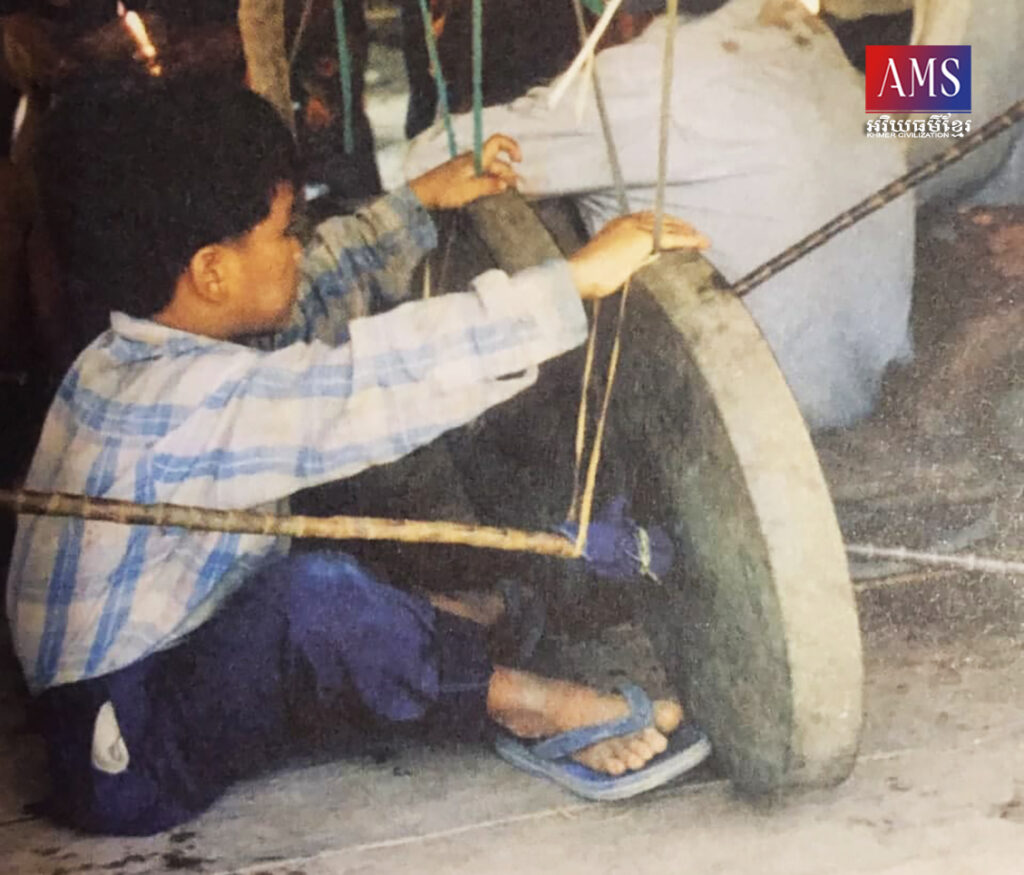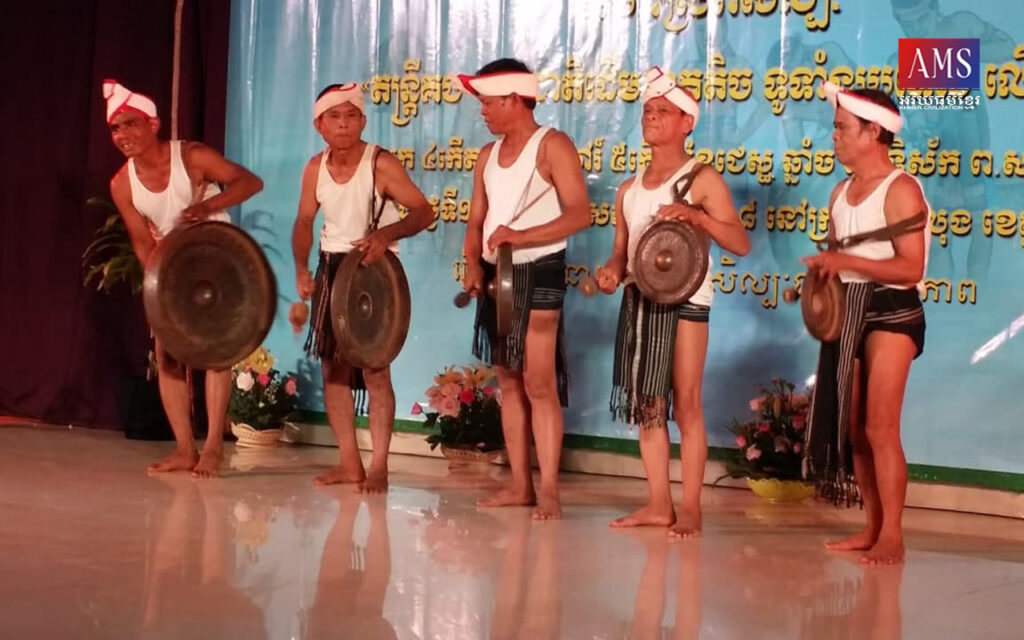អត្ថបទនេះ នឹងផ្តោតទៅលើគង និងវង់គងនៃជនជាតិភាគតិចដែលរស់នៅក្នុងតំបន់ភ្នំភាគឦសាននៃប្រទេសកម្ពុជា ជាពិសេសវង់គង ២, ៥, ៧, ១២ និង១៣ផ្លែ។ អត្ថបទនេះ ក៏នឹងបញ្ជាក់ផងដែរនូវភាពខុសគ្នារវាងទ្រឹស្តីនិងការអនុវត្ត នៃទំនៀមទម្លាប់គងជនជាតិភាគតិច ក៏ដូចជាផ្តល់នូវចម្លើយចំពោះសំណួរខ្លះដែលទាក់ទងនឹងចំនួនផ្លែគង ដែលមាននៅក្នុងវង់គង។ រឿងរ៉ាវនិងភាពខុសគ្នា ដូចជាវង់គង១២និង១៣ផ្លែ ឬពេលខ្លះ គេឃើញវង់គង១២ផ្លែ មានតែ១១នាក់សម្តែង គឺប្រាកដជាមានមូលហេតុរបស់វា។ ករណីនេះហើយដែលខ្ញុំចាត់ទុកថាជាភាពខុសគ្នារវាងទ្រឹស្តីនិងការអនុវត្ត។
ជាមួយក្រុមស្រាវជ្រាវរបស់ខ្ញុំ នៅចន្លោះឆ្នាំ២០០២និងបច្ចុប្បន្នកាល យើងបានចុះទៅធ្វើស្រាវជ្រាវទៅខេត្តរតនគិរី ជាតំបន់ដែលមានជនជាតិភាគតិចរស់នៅច្រើន។ យើងបានធ្វើដំណើរទៅស្រុកវើនសៃ ដែលមានចម្ងាយពីទីរួមខេត្តបានលុងប្រមាណ៤០គីឡូម៉ែត្រ ទៅទិសខាងលិចនៃខេត្ត។ យើងបានទៅដល់ភូមិរ៉ាកនិងភូមិដ្រាក ឃុំកុកឡាក់ ស្រុកវើនសៃ ដែលមានជនជាតិកាវ៉ែតព្រមទាំងវង់គង២ផ្លែ ហៅ «ហ្គងថាយ» និងវង់គង៥ផ្លែ ហៅ «ហ្គងឈើង»។
ជនជាតិកាវ៉ែត ប្រើវង់គង២ផ្លែនេះនៅក្នុងពិធីអាពាហ៍ពិពាហ៍ ពិធីបូជាគង និងនៅមុនពេលផឹកស្រា ដឹកនាំដោយមេភូមិឬអ្នកចាស់ទុំក្នុងភូមិ។ ក្នុងការសម្តែង គង២ផ្លែ (ឈ្មោលមួយ ញីមួយ) កាន់និងទប់ដោយមនុស្សម្នាក់។ ក្នុងស្ថានភាពដែលយើងបានសង្កេតនោះ គឺមានក្មេងប្រុសម្នាក់កាន់និងទប់គង ហើយមនុស្សពីរនាក់ទៀតលេងឬវាយគងនោះ ដោយឈរទល់មុខគ្នា វាយឬបុកផ្លែគងដោយអន្លូងដែលមានដងវែងមួយគូ។ ដងវែងនៃអន្លូង ធ្វើពីប្រភេទរុក្ខជាតិពិសេសមួយ ហៅ «ច្រា» ស្រដៀងទៅនឹងឫស្សីដែរ តែមានថ្នាំងខ្លីៗ។ គេចងចុងម្ខាងនៃដងនោះ ភ្ជាប់ទៅនឹងគង ដោយដាក់ក្បាលនៃដងអន្លូង (ផ្នែកខាងចុងធំហើយក្រាស់) ទៅចំកណ្តាលផ្លែគង។
យើងឃើញទំនៀមនៃឈុតគង២ផ្លែនេះ នៅក្នុងចំណោមជនជាតិភាគតិចមួយក្រុមទៀត គឺជនជាតិព្រៅ ក្នុងខេត្តរតនគិរី ក្នុងការរួមផ្សំឧបករណ៍និងបច្ចេកទេសលេង។ ឈុតគង២ផ្លែរបស់ជនជាតិព្រៅ ហៅ «ហ្គងថាស់» ឬ «កាពីងតាក់មឿត» (កាពីង = ប្តីឬគងធំ, តាក់មឿត = ប្រពន្ធឬគងតូច)។ លោក ទុត អាង អ្នកចាស់ទុំក្នុងភូមិបានប្រាប់ថា “ក្នុងភូមិសឿងសាយ មានឈុតគងនេះចំនួនបីឈុត”។ គងមួយគូដែលយើងបានឃើញនោះគឺមានភាពប្លែកជាងគេ ព្រោះសភាពនៃឈុតគងនោះមើលទៅមានអាយុចាស់ ហើយមានកម្រាស់ក្រាស់និងធ្ងន់ខុសពីគងធម្មតា។
លោក ទុត អាង មានប្រសាសន៍ថា មានតំណមខ្លះចំពោះការលេងគង២ផ្លែ ព្រោះគងនេះមានអារក្ស «រ៉ាយើ» ថែរក្សា។ ប្រសិនបើប្រើវាខុស គេត្រូវរៀបពិធីដោយយកចំបើងស្ងួតទៅដាក់នៅលើគង រួចហើយដុតចំបើងនោះដើម្បីកំដៅគងដោយមានពាក្យពោលបន់ស្រន់ផង។ គេប្រើវង់គង២ផ្លែនេះនៅក្នុងឱកាសនិងពិធីផ្សេងៗ ដូចជាពិធីអាពាហ៍ពិពាហ៍ ឬបុណ្យសពជាដើម។ ឯបទដែលគេលេងជាមួយនឹងគង២ផ្លែ មានបទ «តាកឡាកតាវឡា» ឬ «តាកឡាកចេញ» សម្រាប់ពិធីឡើងផ្ទះថ្មី កាប់ក្របី និងពិធីផ្សេងៗ។ បទ «តាកឡាកឡូងចិត្ត» សម្រាប់ពិធីឡើងផ្ទះថ្មីនិងអាពាហ៍ពិពាហ៍។
ជាទំនៀមទម្លាប់និងប្រពៃណី មុននឹងគេលេងគង ជនជាតិព្រៅ រៀបធ្វើពិធីដោយមានការសែនបូជាមាន់ផង។ ក្រោយពីគេបានសម្លាប់មាន់រួចហើយ គេយកឈាមមាន់ទៅលាបនៅលើគង និងយករោមមាន់ពីរបីសសៃទៅបិទនៅចំកណ្តាលផ្លែគងផ្នែកខាងក្នុង។
ជនជាតិកាវ៉ែត ក៏មានគង៥ផ្លែ ហៅ «ហ្គងឈើង» «ហ្គងប៉ាច» ឬ «ហ្គងជីង» ដែលគេប្រើនៅក្នុងបរិបទផ្សេងៗ មានពិធីផឹកស្រា អាពាហ៍ពិពាហ៍ និងដើម្បីជាចំណងមិត្តភាព។
យើងឃើញមានគង៧ផ្លែនិង១៣ផ្លែ នៅក្នុងចំណោមជនជាតិព្នងនៅភូមិតាកុកព្នង ឃុំបរខាំ ស្រុកអូរយ៉ាដាវ ខេត្តរតនគិរី ដែលមានព្រំប្រទល់ជាប់នឹងប្រទេសវៀតណាម។ ជនជាតិព្នងនៅភូមិតាកុកព្នង លេងវង់គង៧ផ្លែនៅក្នុងពិធីផឹកស្រា ដោយមានការសែនបូជាថ្វាយមាន់ឬក្របីផង។ ផ្លែគងនៅក្នុងវង់គង៧ផ្លែ មានឈ្មោះនិងចែកចេញជា៖ គងមេ ១, គងឈ្មោល ៣, គងញី ៣។ រីឯវង់គង១៣ផ្លែមាន៖ គងមេ ១, គងម៉ុង ២, គងម៉ាង ២ (គងម៉ុង១គូ និងគងម៉ាង១គូនេះមានសូរខុសគ្នា៨សំឡេង) គងកូន ៨។
វប្បធម៌គងមិនអាចផ្តាច់ឱ្យដាច់ចេញពីជីវិតរបស់ជនជាតិគ្រឹងឡើយ ពោលគឺគេតែងតែឮសូរសំឡេងគងនៅក្នុងគ្រប់ពិធីដែលគេរៀបចំធ្វើឡើង។ ជនជាតិគ្រឹងនៅភូមិតងណងឡិ ស្រុកអូរជុំ ខេត្តរតនគិរី ប្រើវង់គង១២ផ្លែ ហៅ «ហ្គងជីង» នៅក្នុងពិធីផ្សេងៗ ដូចជាពិធីបុណ្យចូលឆ្នាំ ពិធីសែនព្រលឹង ពិធីសែនស្រូវទុំ ពិធីកាប់ក្របី បុណ្យសព ឬក្នុងពេលជួបជុំគ្នារាំលេងកម្សាន្តសប្បាយរីករាយដែលមានការផឹកស្រាពាងផង។ គងទាំងនេះលេងដោយប្រុសៗតែប៉ុណ្ណោះ។ កន្លងមក មានអ្នកខ្លះថាវង់គងមាន១២ផ្លែ ឯអ្នកខ្លះទៀតខំប្រកែកថាវង់គងមាន១៣ផ្លែ។ តាមការពិតគឺ ថា១២ផ្លែក៏ត្រូវ ថា១៣ផ្លែក៏ត្រូវ ព្រោះវង់គង មានទាំង១២និង១៣ផ្លែ។
សរុបសេចក្តីមក អត្ថបទនេះ បញ្ជាក់អំពីការប្រើប្រាស់វង់គងខាងលើនៅក្នុងពិធីផ្សេងៗ ដូចជាពិធីអាពាហ៍ពិពាហ៍ សែនភូមិ សែនស្រូវ សែនចម្ការ លៀងអារក្ស កាប់ក្របី សព។ល។ តាមកិច្ចសម្ភាសរបស់យើង នាសម័យមុន ជនជាតិដើមភាគតិចបានអះអាងថា «អ្នកមាន» គឺអ្នកដែលមានគងនិងវង់គងច្រើន។ វង់គង៥ផ្លែ (គងញីឬគងដោះ) មានសូរប្រហាក់ប្រហែលនឹង៥សូរ ប៉ង់តាតូនិក (Pentatonic)។ ឯវង់គង៧ផ្លែ (គងឈ្មោលឬគងរាប) មានសូរប្រហាក់ប្រហែលនឹង៧សូរ ហឹបតាតូនិក (Heptatonic)។ វង់គង១២ផ្លែ គឺ គងញី៥ផ្លែ បូកនឹង គងឈ្មោល៧ផ្លែ។ វង់គង១៣ផ្លែ គឺ គង១២ផ្លែ បូកនឹងគងជើត១ផ្លែ ដែលគេបន្ថែម។ នៅក្នុងការអនុវត្តជាក់ស្តែង យើងឃើញមានរហូតដល់ទៅ ១៥ផ្លែក៏មាន គឺគេបន្ថែមគងទៅពីលើ ១២ឬ១៣ផ្លែ ជាគងត្រួត ថែមទៀត ដូចដែលយើងបានឃើញនៅក្នុងការអនុវត្តរបស់ជនជាតិគ្រឹងនៅពេលដែលយើងចុះទៅស្រាវជ្រាវ៕
—————————————————————
Gong and Gong Ensembles of the Indigenous Ethnic Groups in Cambodia
The present article focuses on the gong and gong ensembles of the indigenous ethnic groups inhabiting the high plateau in the northeast of Cambodia. I shall look at the two-, five-, seven-, twelve-, and thirteen-gong ensembles.
With my research team, between 2002 and the present, we have made several field trips to the province of Ratanakiri where the indigenous ethnic groups are inhabiting. Our trip took us to the Veun Sai district, located some forty kilometers from the provincial capital of Ban Lung, in the western part of the province. We visited the Rak and Drakk villages, Kokk Lakk commune, Veun Sai district, home to the Kavaet two-Gong set called Gong Thay and the five-Gong set called Gong Chheung.
The two-Gong set is used at weddings, during the Gong-worship ceremony, and before wine, drinking led by the village chief or the elderly. In performance, the two gongs (one male and the other female) are held by one person. In the situation we observed, the Gongs were held by a young boy, and played by two men, one at the opposite side, each with two long-handled sticks (see photograph). The sticks are of a special species called Chra, resembling bamboo but with short nodes. One end of the sticks is tied by the string while positioning the heads of the sticks (thicker end) at the center of the Gongs.
This unique two-Gong-set tradition can also be found among another ethnic group‒the Preou‒in Ratanakiri province, in instrumental combination and playing techniques. The Preou two-Gong set is called Gong Thah or Kaping-Takk Moeut (Kaping = husband, the larger Gong; Takk Moeut = wife, the smaller Gong of the set). “There are three sets of Gong Thanh in the Soeurng Say village,” said a villager elder, Mr. Tuth Ang. The pair that we saw was very unique for they looked old and were unusually thick and heavy.
There are certain restrictions attached to the playing of this two-Gong set or ensemble. “The Gongs are spiritually possessed by the Arakk Rayeu,” said Mr. Tuth Ang. If used them wrongly, villagers must perform a ceremony by taking dried straws to place over the Gongs and burn the straws to warm the gongs with words of prayer. The two-gong ensemble is used in various occasions, including weddings, village-worship ceremonies, buffalo sacrifices, wine drinking, or funeral, and so on. The two-gong ensemble repertoire includes pieces:
Ta Lak Tav La New house warming
Buffalo sacrifice
Other ceremonies
Tak Lak Chenh New house warming
Buffalo sacrifice
Other ceremonies
Tak Laung Chett New house warming
Wedding
Before the gongs are played, members of the Preou must perform a ceremony, which includes chicken sacrifice. After the chicken is killed, the chicken’s blood is used to smear over the gongs, while a few strands of chicken’s feather pasted in the middle on the inside part of the gongs.
The five-Gong ensemble is called gong Chheung (Kavaet dialect) or Gong Pach (also Ggong Ching). It is used in various contexts, including wine drinking, wedding, and friendship building.
When we visited a remote Pnorng village of Takokk Pnorng, Bar Khaim commune, Aur Yadav district, Ratanakiri province, near the board of Cambodia-Vietnam, we found a few Gong ensembles, including the seven-Gong and thirteen-Gong ensembles. The seven-Gong ensemble is played during drinking along with offerings of chickens or buffaloes. The breakdown of the two-Gong sets is:
Seven-Gong Ensemble
Lead Gong 1
Male Gongs 3
Female Gongs 3
Thirteen-Gong Ensemble
Korng Me 1
Korng Mong 2
Korng Mang 2(Each of the pairs of Korng Mong and Korng Mang is one octave apart.)
Korng Maun 8
Gongs are indispensable in the life of the Kroeung ethnic group. They are played and heard in virtually every gathering and ceremony. They identify the different ceremonies by the repertoires played. Among the Kroeung ethnic group in Tang Nang Lek village, Aur Chum district, Ratanakiri province, Gong Ching is a twelve-gong ensemble (bossed and flat) used in various ceremonies, such as New Year, spirit-worshiped ceremonies, during the time when rice paddies are ripe, buffalo sacrifice, funeral, or a mere celebration for joy including wine drinking. These Gongs are played by men only, and the young Kroeung often use the twelve-Gong ensemble for casual dancing as well.
អត្ថបទដើម៖ បណ្ឌិត សំ សំអាង









